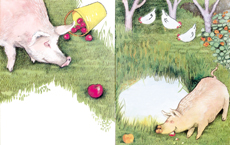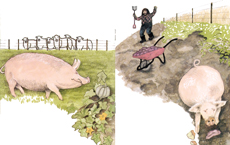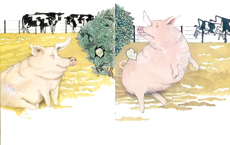|
Approach: One
to one |
| Focus:
Accuracy
of oral reading in Mäori. |
 |
5.2MB |
Resources:
3
story books in Mäori. |
|
Questions
/ instructions:
In this activity we have some stories
that are written in Mäori. Some children can read a little bit
in Mäori, and others can read a lot.Here are three very short stories
that are written in Mäori.I would like you to have a go at reading
this first little story. It doesn’t matter if you can’t read
all of it, but have a go.
E toru ënei körero paki kua tuhia i
roto i te reo Mäori.
Ka pänuitia e koe, ënei pukapuka e toru.
|
| |
|
|
%
responses
|
|
GEd
|
MI
|
|
First book:
Ngä
Manu i Runga i te Räkau
|
|
|
Let’s
begin with the first story, which is about birds. As you read out loud,
think what the story is about. If you come to words you can’t read,
just give them a go, and carry on with the story. When you’ve finished
reading, I’ll ask you to tell me what the story was about.
Student reads independently of help from the teacher, but with encouragement. |
1.
Have you read this story before?
2. Tell me what the story was about.
3. How many birds were there altogether?
4. What happened at the end of the story? |
|
Pukapuka Tuatahi: Ngä Manu i Runga i te
Räkau. |
Anei
te pukapuka tuatahi. Pänui mai ä-waha me te whakaaro anö
ki te kaupapa o te körero. Ki te kore koe e möhio ki tëtahi
kupu, me tahuri noa [try/tarai/ngana], ä, ka haere tonu. Kia
mutu tö pänui me kï mai koe, he aha te kaupapa o te körero.
Mä te äkonga tonu e kawe i a ia anö, ko tä te kaiako,
ko te whakahau i a ia. |
1.
Kua pänui anö koe i tënei körero i mua?
2. Körerohia mai te kaupapa o taua körero.
3. E hia ngä manu katoa?
4. I ahatia, i te mutunga o te körero? |
| |
full
attempt to read |
93 |
100 |
| had
read story before |
4 |
74 |
| 0
– 10% errors |
36 |
100 |
| Comprehension
|
more
and more birds landed on branch |
71 |
88 |
|
eventually
10 birds |
85 |
98 |
| branch
broke |
51 |
54 |
| birds
flew away |
44 |
72 |
| OVERALL
SUCCESS |
27 |
84 |
Show
the story titled Poaka Kunekune and ask the student if they think
they might be able to read it. If they say yes, carry on. If not, discontinue
the task.
Poaka Kunekune is a little story about a pig. Read it out
loud to me, then I’ll ask you what it’s about. |
|
|
 |
 |
|
1.
Titiro ki te äporo nei.
He reka te ähua.
He tino reka!
2.
Titiro ki te pïtiti nei.
He reka te ähua.
He tino reka!
|
3.
Titiro ki te paukena nei.
He reka te ähua.
He tino reka!
4.
Titiro ki te kümara nei.
He reka te ähua.
He tino reka!
|
 |
 |
|
5.
Titiro ki te rëmana nei.
He reka te ähua…
6.
A U E E E!
|
7. He
tino kawa!
|
|
5.
Have you read this story before?
6. Tell me what the story is about.
7. What did the food taste like?
8. What happened to the pig at the end of the story? |
Whakaaturia
te pukapuka Poaka Kunekune.
Ko te Poaka Kunekune, he körero tënei mö tëtahi
poaka. Pänui mai ä-waha. Kätahi ka pätai au, he aha
te kaupapa o taua körero.
Mä te äkonga tonu e kawe i a ia anö, ko tä te kaiako,
ko te whakahau i a ia. |
5.
Kua pänui anö koe i tënei körero i mua?
6. Körerohia mai te kaupapa o taua körero.
7. I pëhea te rongo [taste/ngao/reka] o te kai?
8. I te mutunga o te körero i ahatia te poaka? |
| |
|
full
attempt to read |
76 |
100 |
| |
|
had
read story before |
4 |
74 |
| |
|
0
– 10% errors |
19 |
100 |
| |
Comprehension
|
about
a pig |
75 |
94 |
| |
|
pig
ate fruit and vegetables |
39 |
90 |
| |
|
pig
found food delicious, sweet |
39 |
88 |
| |
|
mentioned
all apple, peach, pumpkin, kumara |
3 |
12 |
| |
|
pig
tried to eat lemon |
17 |
78 |
| |
|
pig
upset — lemon sour |
20 |
84 |
| |
|
OVERALL
SUCCESS |
13 |
94 |
Show
the story titled Karengo and ask the student if they think they
might be able to read it. If they say yes, carry on. If not, discontinue
the task.
The
family in the story are gathering karengo to eat. Read the story to the
end of page 7, then I’ll ask you what it’s about. |
|
|
|
|
9.
Have you read the story before?
10. Tell me what the story is about.
11. Why does it say that it’s good to wash karengo?
12. Why does the author say you have to take care when you are cooking
karengo? |
| I
tënei körero, kei te kohikohi karengo te whänau, hei kai
mä rätou. Pänuitia te körero ki te mutunga o te whärangi
7, kätahi ka pätai au mö töna kaupapa. |
9.
Kua panui anö koe i tënei körero i mua?
10. Körerohia mai te kaupapa o taua körero.
11. He aha te take i kïia ai he pai te horoi i ngä karengo?
12. Nä te aha i kï ai te kaituhi, me tino tüpato i
te wä e tunu ana koe i te karengo? |
|
full
attempt to read |
39 |
100 |
| had
read story before |
3 |
24 |
| 0
– 10% errors |
31 |
100 |
| Comprehension |
seaweed
on rocky coast |
4 |
6 |
|
picking
seaweed |
30 |
88 |
| washing
seaweed |
7 |
6 |
| washing
to remove sand/shells |
7 |
42 |
| carry
home in bag |
1 |
6 |
| put
seaweed in dish |
1 |
2 |
| cook
seaweed |
24 |
46 |
| stop
it burning |
8 |
36 |
| OVERALL
SUCCESS |
9 |
40 |
| Total
score: |
3
|
3 |
40 |
| |
2
|
14 |
40 |
| 1
|
12 |
18 |
| 0
|
71 |
2 |
Commentary:
Mäori students in Mäori immersion (MI) settings scored statistically
significantly higher than did Mäori students in general education
(GEd) settings. Given the special focus for MI students on learning Te
Reo Mäori , this finding is not unexpected. |